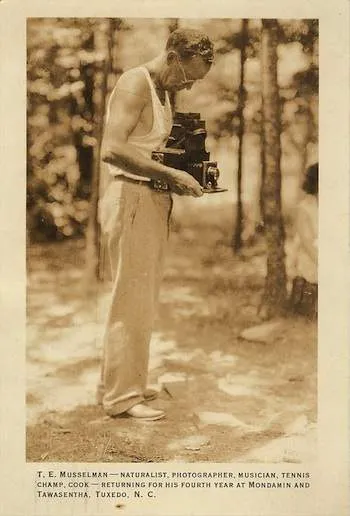
A BLUEBIRDING GIANT, T.E. MUSSELMAN: Born April 28, 1827, died June 12, 1976. He would have known that by that date, American bluebirds had just finished their first mating of the season.
(This information was provided by T.E. Musselman’s granddaughter, Gail Harmeyer, in 2009. Gail lives in Hot Springs Village, Arkansas.)
- Family called him Pappy. He was a strict disciplinarian, but was also great fun. No one called him Tom – everyone called him T.E., although his wife called him Edgar.
- He always had birds and critters he was caring for.
- He gave wonderful talks at an area school.
- His wife (91 as of March 2009) lives in ?
- he would band hundreds of barn swallows in a single day
- He was a handsome man.
- His scientific information was given either to the library at the U of Illinois in Champaign or Illinois State Museum in Springfield?
History Bits
1911-1912: Jack Frost struck again, with a very cold winter in the Southeastern states, but this was more local and recovery was quick. Thomas Edgar Musselman estimated that fifteen hundred to two thousand eggs were frozen in his area in April. (AC Bent).
1926: Thomas E. Musselman of Quincy Illinois is generally credited with originating the bluebird conservation movement that extended beyond local boundaries. He also came up with the concept of a “bluebird trail.” He designed his own boxes with removable tops, and started putting them up along country roads, eventually expanding to 1,000 boxes. He experimented with boxes of different depths, floor sizes, roof styles, boxes made from gourds, logs and cylinders, square holes, “mouse holes” (oval top with flat bottom – upright and inverted), rectangular slots, round and oval holes of various sizes. (Bluebird Monitors Guide, p. 94) He also experimented with ventilation, drainage, floor dimensions and cavity depth in boxes. Musselman was a scientist, businessman, college teacher, family man, naturalist, bird bander, and organizer. T.E. Musselman was born 04/28/87, died at the age of 89. (Bluebird Trails, Coeur d’Alene National Audubon Society, Vol.14, Issue 2., birthdate correction from Gail Harmeyer)
1934: Musselman, who continued to be concerned about bluebird population decline, wrote an article in Bird Lore calling on others to establish trails. There was widespread public participation. In 1934, he set out 25 nestboxes along backcountry roads and monitored them closely. Later on, he had more than 100 boxes over 43 miles. He continued lecturing and corresponding with others interested in bluebirds, such as William Duncan of Kentucky, who corresponded with Musselman from 1930 until Musselman died in 1976. Duncan designed another nestbox style and put up hundreds of boxes in Jefferson Country.
1940: More than 50% of the bluebird population in Illinois died during ice storms (Musselman 1941 per BNA).
1969: NAPPPMBA was dissolved in 1969 and its work passed into the hands of the Griggsville Wild Bird Society (now The Nature Society) which published Purple Martin Capital News (now Nature Society News). This paper published a monthly “Bluebird Trail” column for many years. The column was written by T.E. Musselman prior to 1969, by Larry Zeleny from 1969 to 1981, then by Ben Pinkowksi, Harry Krueger, Marcy Hoepfnar, Steve Garr, and others. This column created widespread interest in bluebird conservation throughout much of the United States and Canada.
1976: Larry Zeleny published The Bluebird – How You Can Help Its Fight for Survival. Zeleny estimated that bluebird populations declined drastically from the late 1920s-1970s. He estimated that the Eastern Bluebird population had declined by 90% over that period based on his own recollections and other friends of bluebirds who had lived long enough (From Bluebirds! By Grooms and Peterson). T.E. Musselman died, after more than 70 years exploring bluebird conservation and educating others.
– John of Salisbury, Metalogicon, 1159
